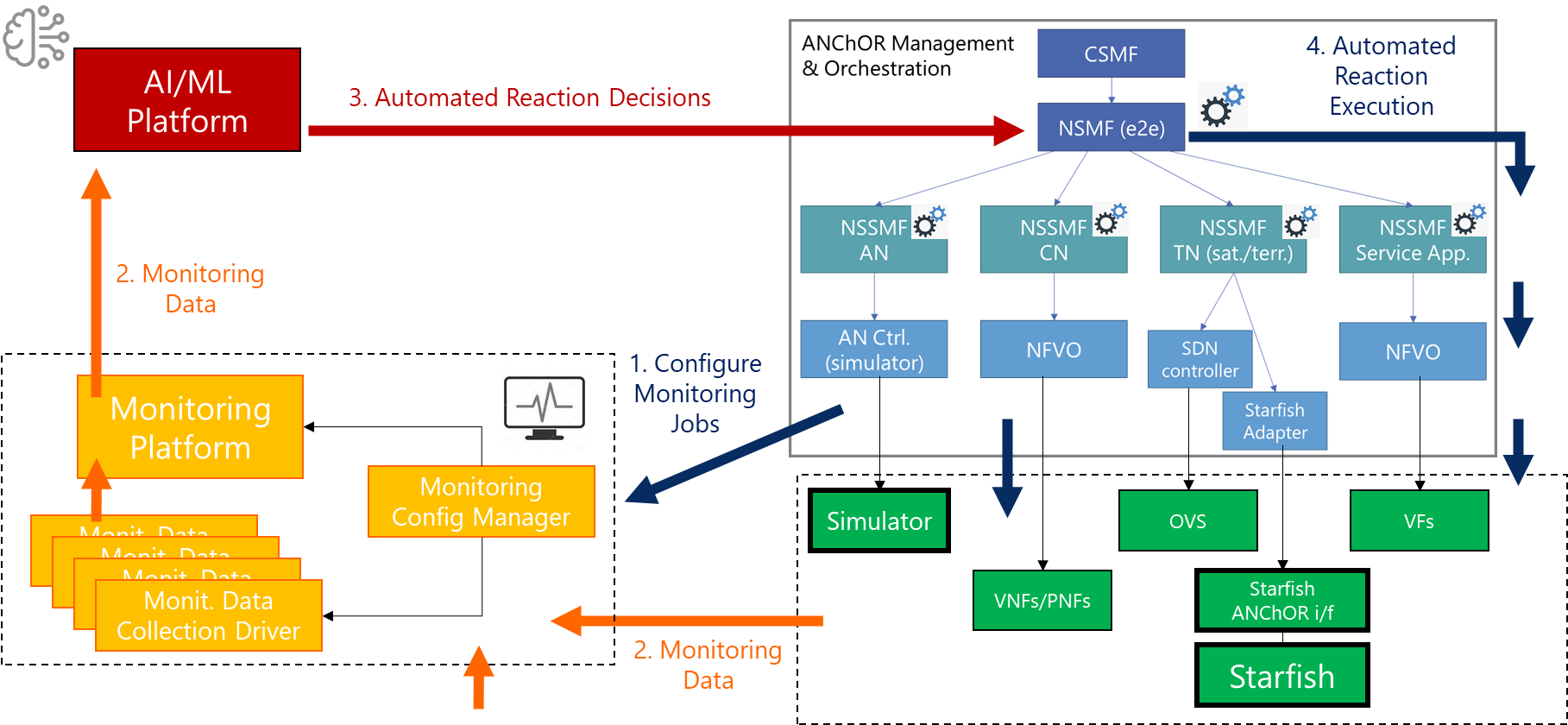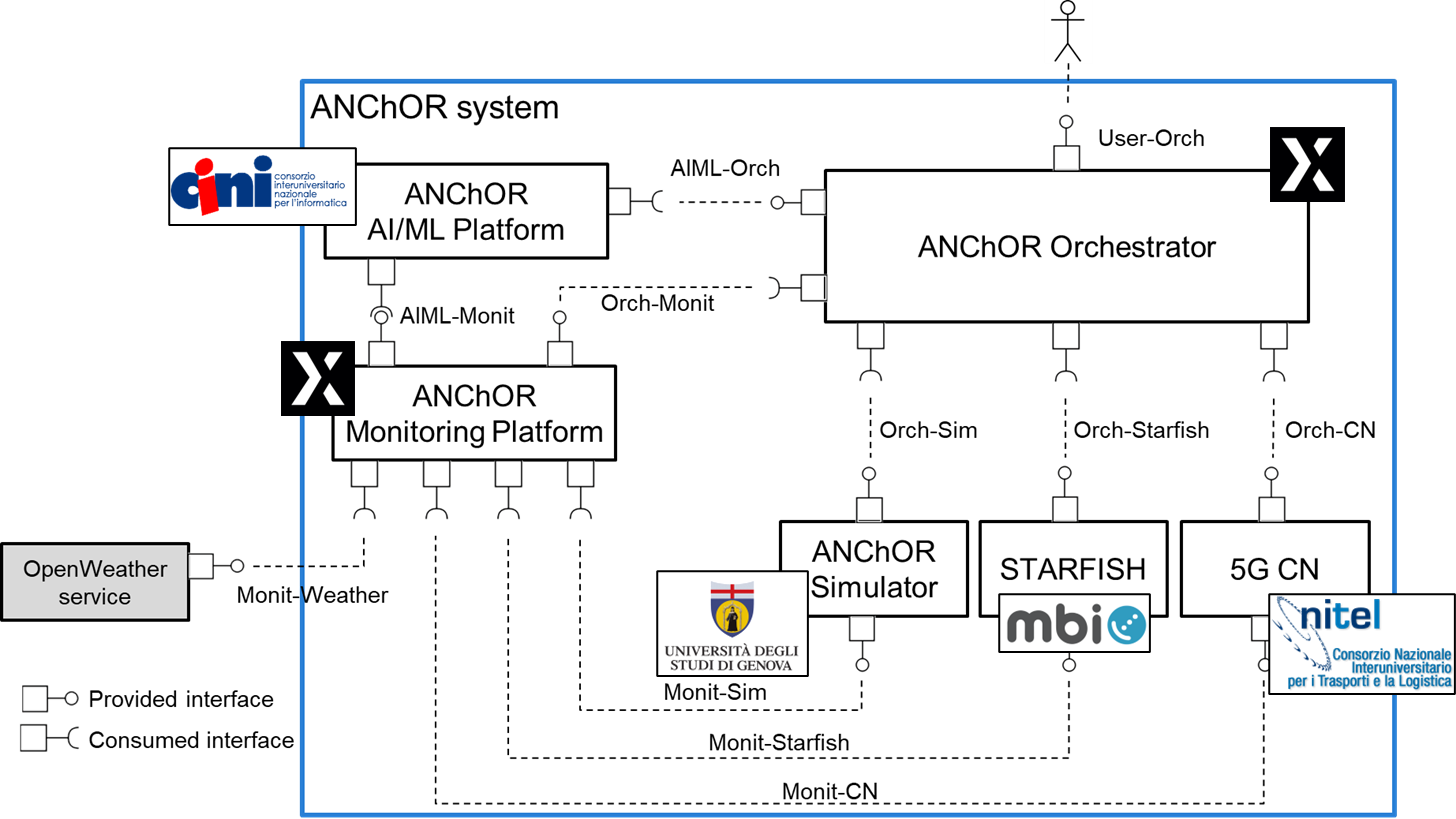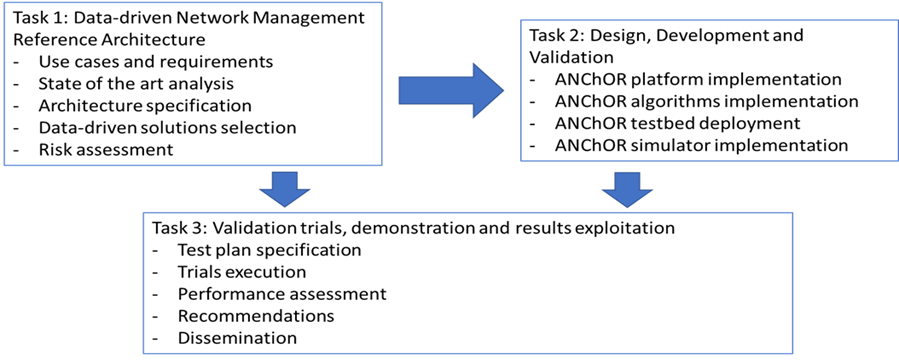
-
StatusCompleted
-
Status date2024-01-10
-
Activity Code3A.108
ANChOR objectives are focused on the design and implementation of an integrated infrastructure for 5G Satellite-Terrestrial networks, with data-driven orchestration techniques applied to the optimization of the multi-domain network.
The project aims to investigate satellite-based extensions to 5G architecture and use cases, targeting eMBB and mMTC services, analyzing new business models and multi-domain deployments combining NR and satellite networks. In this direction, ANChOR has the objective of building an orchestration solution, compliant with ETSI NFV and 3GPP standards, that adopts Artificial Intelligent (AI) and Machine Learning (ML) techniques for a truly dynamic and data-driven resource allocation and slice management.
ANChOR orchestration strategies want to extend the self-optimization and self-adaptation concepts to the management of satellite-enabled 5G infrastructures, through an end-to-end resource control across access, edge and core domains. Management functions of satellite networks are virtualized and orchestrated as an integrated part of the 5G infrastructure, with zero-touch re-configurations on the basis of real-time data about service requirements, network conditions and traffic load.
The evaluation of ANChOR solution involves Over-the-Air tests for Geostationary (GEO) backhauling scenarios with eMBB services, combined with NR simulations for a Low Earth Orbit (LEO) access modelling applied to NarrowBand – Internet of Thing (NB-IoT) communication scenarios.
Two use cases have been selected for ANChOR demonstration. UC1 targets eMBB network slices over a 5G network with GEO satellite technology in the backhaul domain, between the RAN/edge infrastructure and the 5G Core Network. UC2 exploits the LEO satellite communications at the access network for mIoT network slices.


The ANChOR challenge is to enable the intelligent and automated orchestration of satellite resources as integrated part of the overall 5G infrastructure. Exploiting the NFV and zero-touch paradigms, satellite control functions must be dynamically instantiated and re-configured to meet the variable requirements of concurrent network slices and automatically re-adapt to the real-time environmental context, network conditions and traffic loads. In such dynamic scenarios, data analytics and AI/ML techniques are fundamental to drive orchestration decisions, which needs to be complemented with control strategies to guarantee the continuous stability of the network.
The ANChOR platform introduces several innovations in the orchestration area, bringing several benefits to the management of 5G networks deploying satellite technologies.
-
Satellite control functions are virtualized and managed as integrated part of the end-to-end 5G infrastructure, with the possibility to adopt global, cross-domain orchestration strategies.
-
The data-driven orchestration, exploiting its embedded AI/ML techniques, enables network automation strategies for self-configuration, self-optimization and self-healing actions following the closed-loop and zero-touch paradigms.
-
The ANChOR-based 5G infrastructure adopts unified management mechanisms across multiple domains and multiple technologies, combining hybrid satellite/radio access and edge/cloud resources, in support of a diversity of vertical services and network slices.
-
AI/ML techniques are applied to cross-layer orchestration procedures, enabling algorithms to jointly manage 5G infrastructure resources, transport connectivity, network slices up to vertical services and QoS assurance.
-
ANChOR data analytics solution relies on a flexible and open monitoring platform, supporting the efficient collection, storage, publishing and processing of cross-layer and cross-domain monitoring data.
-
ANChOR orchestrator relies of AI/ML techniques to improve the efficiency of resource allocation, function placement and migration decisions, for joint and real-time optimization of network and IT resources across satellite and radio access, distributed edge nodes, transport and core networks, applying multi-slice and multi-tenant paradigms.
ANChOR platform offers advanced features for the orchestration of 5G Satellite-Terrestrial networks:
-
Adoption of AI/ML techniques for closed-loop automation and data-driven optimization of resource allocation and satellite-enabled 5G infrastructure management.
-
Data analytics applied to monitoring data from multiple data sources, including 5G infrastructure, network functions, orchestration platform, service applications, external data repositories.
-
Management and arbitration of multi-tenant network slices for differentiated categories of vertical services.
-
Unified control of heterogeneous network technologies.
-
End-to-end resource management strategies, across access, edge, core domains.
-
Real-time adaptation of 5G infrastructure configuration and network slices, with embedded mechanisms to guarantee the network stability.
-
Zero-touch approach for automated configuration of virtualized satellite network functions.
-
Compliance with ETSI NFV and 3GPP standards (NFV MANO, network slicing, NWDAF).
-
Adoption of open APIs and flexible software architecture to easily integrate third party algorithms and additional data sources as input for data analytics and AI/ML engines.

The ANChOR architecture proposes a multi-domain, satellite-enabled 5G infrastructure jointly orchestrated through AI/ML techniques. The AI/ML engines drive closed-loop automation decisions for allocation of network and computing resources and management of network slices. Starting from multi-domain, multi-layer monitoring data, the AI/ML algorithms produce dynamic models that are translated into automation commands to assist the orchestration. Service provisioning, slice management, resource allocation, configuration and migration are continuously re-optimized, according to the real-time dynamicity of service demands and context conditions.
On top of the 5G Satellite-Terrestrial network infrastructure, the ANChOR platform is composed of three functional elements that jointly implement the closed-loop network automation, interacting through open interfaces.
The ANChOR Management and Orchestration platform implements the lifecycle logic to manage vertical services, end-to-end slices and NFV network services. It orchestrates resources across the satellite/terrestrial access, core, transport networks, edge and cloud domains.
The ANChOR Multi-Technology Resource Controllers implement the control plane of network domains, e.g. through technology-specific SDN controllers, and manage the virtual infrastructure for edge and cloud resources.
The ANChOR AI/ML platform embeds the data-driven intelligence to assist the system automation, on the basis of multi-source monitoring information about network load, service requirements, application performance, external context evolution, etc.
The internal design of the ANChOR architecture is inspired by 3GPP and ETSI NFV standards for 5G network slice management, orchestration of NFV network services through an NFV MANO framework, and monitoring and data analytics in 5G networks. ANChOR innovations are implemented through two main architectural extensions.
The integration of satellite networks is managed at the orchestration level, extending the logic of the network slice (subnet) management (NSMF and NSSMF) to operate over satellite resources. A new sat controller dedicated to satellite networks, based on STARFISH, enables control and monitoring functionalities as well as the implementation of the network slice concept at the satellite domain. The interaction between ANChOR orchestrator and the satellite controller is handled through a new open interface.

The data-driven automation procedures follow the closed-loop model. ANChOR monitoring and AI/ML platforms represent an extended version of the Management Data Analytics Function (MDAF) defined in the 3GPP management system. The collection of monitoring data from the 5G Core Network, through network probes at the UPF, implements NetWork Data Analytics Function (NWDAF) functionalities. The interaction with the ANChOR orchestrator to trigger the execution of the automation decisions is based on new open interfaces to request the reconfiguration of the end-to-end network slice and, in particular, the re-allocation of resources and/or traffic flows over the sat-enabled slice subnets in the transport network domain.

ANChOR System Prototype
The prototype of the ANChOR system is released as open-source software and it is available in a public Gitlab repository https://gitlab.com/anchor5

The ANChOR orchestrator is in charge of coordinating all the actions for the provisioning of end-to-end network slices across the access, satellite/terrestrial transport and core domains and for the execution of the closed-loop actions issued by the AI/ML platform for the re-configuration of the satellite network.
The ANChOR monitoring platform is in charge of collecting and storing monitoring data from different data sources (NWDAF, weather service, Starfish, etc.) and making them available via data streaming or Time Series Database to the AI/ML platform.
The ANChOR AI/ML platform elaborates monitoring information related to network performance and identifies the re-configuration actions needed to continuously optimize the network utilization. The AI/ML algorithms for UC1 are based on convolutional neural networks with LSTM and GRU based models implemented using Keras with Teraflow for task 1 and task 2, and Decision Tree and SVC models using sklearn library for task 3. For use case 2 they are based on a Combinatorial Multi-Armed Bandit game, operating in scalable scenarios with up to 1000 UEs and 1000 gNB.
The Starfish platform is responsible for the control and management of the satellite network in the backhaul segment in UC1. It provides features for slice provisioning, monitoring and on-demand re-configuration of satellite networks (gateway switching and ACM configuration).
The 5G CN is a custom implementation of the 5G Core Network integrated in the ANChOR testbed and extended with monitoring functionalities (collection of monitoring data at UPFs, implementation of NWDAF, configuration of network slices via SMF).
The ANChOR simulator, based on Network Simulator 3 (ns-3), integrates new components to simulate a 5G satellite-terrestrial network with LEO satellites at the 5G access segment. The tool simulates a network where LEO satellites operate as moving gNBs equipped with 5G NR interfaces and it allows to test different network topologies and data traffic flows, setting number of satellites and their position, satellite orbital parameters, number and position of UEs, and statistical parameters of the traffic flows generated and received by the UEs.
The ANChOR system is complemented by the OpenDaylight SDN controller (for traffic steering in terrestrial backhaul network) and the OpenSourceMano (OSM) NFV Orchestrator, with OpenStack as Virtual Infrastructure Manager for VNFs’ deployment.
The project is structured in three phases, starting from use cases and architecture design, and evolving in the development phase to conclude with validation trials and demonstrations. The first milestone, Baseline Design Review (February 2021), focused on use case specification. In July 2021, the ANChOR architecture and the AI/ML and data mining solution design were released for the Critical Design Review. The ANChOR platform prototype and its test plan were covered at the Preliminary Performance Review (September 2022), while the results of the validation trials were delivered at the end of the project in December 2022 for the Final Review.

The project has been successfully completed, with the specification of the two target use cases on eMBB ad mMTC services, the design of the ANChOR system architecture, as well as its deployment and service models, followed by the implementation of the ANChOR system software prototype and its deployment in the ANChOR testbed. Finally, the ANChOR concepts have been validated via simulations and experimental validation through OTA testing.







